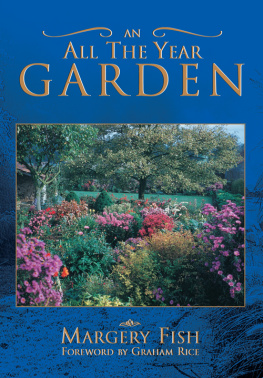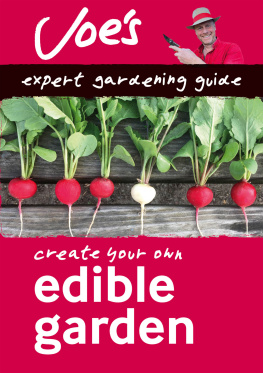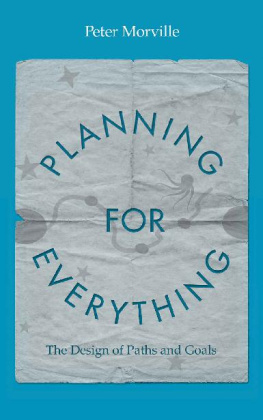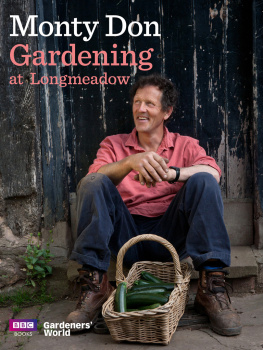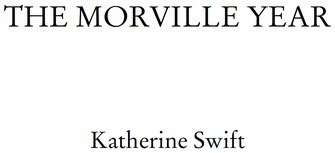for Mirabel Osler
Contents
From the December of 2001 to the July of 2005 I wrote a weekly column about gardening for the Saturday edition of The Times newspaper. For a dozen or so years before that, I had been keeping a diary about the making of the garden at Morville in Shropshire, where I had come to live in 1988. The columns seem to have taken the place of the diaries (certainly I wrote no more diaries after 2001), and are thus a record of what I was doing and thinking each week in my own garden, together with the books I might have been reading, occasional trips I might have made to see plays or exhibitions in London and elsewhere, and forays into other peoples gardens, all of which provided stimulus and ideas for the garden I was making at home.
The idea behind the garden was to try (by means of a series of gardens-within-a-garden) to tell the history of the house and its setting and, incidentally, of English gardening as it unfolded over a period of a thousand years or so. When I began the research that would underpin the garden, I found that every plant had a story who first grew it or collected it from the wild, gave it a name or painted its picture, wrote a poem about it or used it to cure some ailment? Every one came trailing clouds of glory. Many of these preoccupations are reflected in the columns: there is much here about the plant-hunters and the histories of individual flowers, from a handful of the old florists flowers (tulips, auriculas, pinks, anemones, gold-laced polyanthus, hyacinths) to fruit trees (pears, plums, apples, quinces), herbs medicinal and culinary, old vegetables like cardoons, cottage garden flowers like peonies and (especially) old roses which between them formed the backbone of the garden as well as a lot about lilies and agapanthus (which I fell for in a big way). In the columns, I go to see Raphaels Madonna of the Pinks and admire William Nicholsons painting of dandelions. I take up bee-keeping and buy a motorbike. There is a long-running debate with myself about wildness and self-seeding in the garden, and the extent to which, even within a formal garden, one can step back and let Nature take a hand; Losing Control is one of several such gleeful episodes.
By 2001 the broad outline of the garden and much of the planting was in place, but there was plenty of tinkering going on as I continued to collect plants, to arrange and rearrange them, and to see what would do and what would not in my red Shropshire soil. The columns thus record my own deliberations and discoveries at the time they were being made, the gathering of information and the weighing of pros and cons as largely by trial and often by error I made my own decisions about plants and planting, pruning and maintenance, the siting of a garden seat or the choice of a colour scheme. But whatever the weekly subject, one constant theme was the weather, the turning of the seasons: that sense of being out of doors, vigilant for those tiny signs (and sudden reversals) first dewfall of autumn, perhaps, or threat of late frost in spring that signal big changes in the life of the garden and its occupants. In the world of the columns, those inhabitants included not only me and my plants, but peacock butterflies and hawk moths, blackbirds and robins, foxes and rabbits, bumble-bees and to the dismay of some readers and the delight of others my tribe of cats. (The account of Grace making an elegant beeline for a blackbirds nest (It Must Be Spring) provoked howls of outrage the single biggest post-bag the column ever received; my neighbour Bridgets cat Blackberry, on the other hand a devilishly successful hunter of rabbits acquired his own fan club.)
The idea of close looking, the attentive chronicling of plants and flowers in the garden at all stages of their growth, in all weathers, not simply when in flower, runs through the columns, a constant exhortation to the reader (but above all to myself) to look: really look; tomorrow may be too late (Carpe Diem). I see now that this close looking, and the linked theme of carpe diem (seize the day), is the mainspring not only of many of the columns Just Looking is another example but of all my writing, generating not simply the urge to record but the need for precision, the search for exactly the right word. I am conscious that this often led (and leads) to strings of adjectives (a journalistic solecism) and often, when plainer words failed, to simile and metaphor (a frequent target for The Times sub-editors). But I am unapologetic. The aim was always to capture, as precisely as possible, the fleeting nature of a particular day, a particular cast of the weather, a particular plant: a moment in my life.
The writing of the columns also ran concurrently with the writing of The Morville Hours, a project begun in 1993 and worked at intermittently for the next fifteen years until it finally saw publication in 2008. That book told the story of how I came to Morville and began to make the garden, interwoven with the stories of the many other people (present day as well as long past) who had lived at Morville and whose lives ran parallel with mine. Some of the themes of The Morville Hours are also thus reflected in the columns (a fascination with the peculiarities of calendars and other methods of measuring time; the procession of saints days and other feasts of the liturgical calendar which make up the church year), though the columns are generally more practical in tone and content, often providing me with a way of dealing with a problem or an idea more directly than was possible within the pattern of the book, from which they came to be both an escape and a relief.
The addressee of the columns is frequently a conversational you, not in any prescriptive sense, but with the sort of fellow feeling that might have been conveyed in an earlier age by one. Writing the column came to be like writing a weekly letter to a circle of gardening friends friends who, I felt, would sympathise with my all too frequent failures, laugh at my follies and join in my occasional triumphs, understanding what a switchback ride of highs and lows making a garden is.
I had always written about my gardens, and whether the columns supplanted the diaries or not, there was never any question of ceasing to record in some form or other my life in the garden. What had begun in 1970 as bare chronology lists of jobs to do and jobs done (or more often un-done) each week in my first garden on the outskirts of Oxford had by 2001 become a detailed record of thoughts and feelings and observations. The writing had become a way of thinking aloud, a way of answering that perennial question, What if?, conjuring a new garden or a new part of the garden into existence by means of words on the page. That process is described in one of the earliest columns reprinted here (In Praise of Winter), which tells the story of how in 1989, my first winter at Morville, I read and dreamed and cross-referred and made lists, writing the guidebook to a garden which did not yet exist: by March my imaginary garden was so real that I could walk about in it and smell the flowers. Reading, writing and gardening remain for me indissoluble, the garden not simply the physical place where I spend most of my days, but a mental space built out of thoughts and emotions, associations and memories mine and other peoples.


